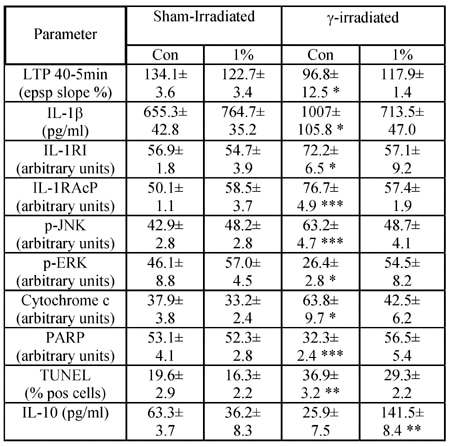Radiotherapy treatment has been shown to result in deficits in hippocampal-dependent cognitive function. We set out to assess the possibility that whole body gamma-irradiation increases hippocampal IL-1β concentration and investigate the downstream consequences.
Male Wistar rats were housed in four groups (n = 6 per group); two groups were fed on laboratory chow (control diet) and two groups were fed on chow supplemented with 250 mg eicosepentaneoic acid (EPA; 1 % diet) for 4 weeks. Next, two groups (control and 1 % diet) were exposed to whole body irradiation (10 Gy at a rate of 10 Gy min-1) and the two remaining groups were sham-irradiated. All groups were monitored for 4 days, anaesthetized by intraperitoneal injection of urethane (1.5g kg-1) and assessed for their ability to sustain long term potentiation (LTP) in perforant path granule cell synapses. At the end of the electrophysiological recording, rats were killed by decapitation and the hippocampus was removed for analyses (Lonergan et al. 2002). Statistical analysis was assessed by a one-way ANOVA followed by a post hoc Student-Newmann-Keuls test. Data are represented by means ± S.E.M. and considered significant when P < 0.05 (*P < 0.05; **P < 0.01; ***P < 0.001).
We present evidence which reveals that irradiation leads to cell death in the hippocampus, and as a consequence, LTP is markedly impaired. The irradiation-induced increase in IL-1β concentration in hippocampus is accompanied by increased expression of IL-1 type I receptor and IL-1 accessory protein. These changes are coupled with increased activation of c-Jun N-terminal protein kinase (p-JNK), decreased activation of extracellular signal regulated kinase (p-ERK), and with evidence of cell death; namely parallel increases in cytochrome c translocation, poly(ADP-ribose)polymerase (PARP) cleavage and Tdt-mediated dUTP nick-end labelling (TUNEL) staining. Significantly, the irradiation-induced changes in hippocampus are abrogated by treatment of rats with EPA. When the irradiation-induced cell death was prevented by EPA, LTP was sustained in a manner similar to that in the control group.
This work was supported by the Health Research Board (Ireland)

